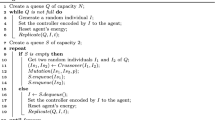Abstract
The phenomenological goal of grounding the content of conceptual thought in the background understanding of everyday, skillful coping was approached using evolutionary autonomous agent (EAA) methodology. The behavior of an EAA evolved to perform a specified motor task was identified with skillful coping. Changes in the dynamics of the EAA controller occurred when the EAA encountered an unexpected obstacle with loss of longer time scale components in its hierarchical temporal organization. These temporal changes are consistent with the phenomenological changes which we experience with breakdown during equipment use with our adoption of a more immediate, determinate stance. Since this latter experience is the basis of conceptual thought, the EAA paradigm goes some way in providing a naturalized explanation for the grounding of the content of conceptual thought in everyday, skillful coping in a manner that is physiologically plausible and phenomenologically accurate.

Similar content being viewed by others
References
Arkin, R. C. (1998). Behavior-based robotics. Cambridge, Massachusetts: MIT.
Beer, R. D. (2003). The dynamics of active categorical perception in an evolved model agent. Adaptive Behaviour, 11(4), 209–243.
Borrett, D. S., Jin, F., & Kwan, H. C. (2005). Evolutionary autonomous agents and the nature of apraxia. Biomedical Engineering Online, 4, 1–9.
Dreyfus, H. (2002). Intelligence without representation – Merleau-Ponty’s critique of mental representation. Phenomenology and the Cognitive Sciences, 1(4), 367–383.
Freeman, W. J. (1999). Consciousness, intentionality and causality. Journal of Consciousness Studies, 6(11–12), 143–172.
Heidegger, M. (1962). Being and time. New York: Harper and Row.
Linkenkaer-Hansen, K., Nikouline, V. V., Palva, J. M., & Ilmoniemi, R. J. (2001). Long-range temporal correlations and scaling behavior in human brain oscillations. The Journal of Neuroscience, 21(4), 1370–1377.
Marsden, D. (1982). The mysterious motor function of the basal ganglia: The Robert Wartenberg lecture. Neurology, 32, 514–539.
Merleau-Ponty, M. (1962). Phenomenology of perception. London: Routledge and Keegan Paul.
Petitot, J. (1999). Morphological eidetics for a phenomenology of perception. In J. Petitot, F. J. Varela, B. Pachoud & J.-M. Roy (Eds.), Naturalizing pheneomenology. Stanford: Stanford University Press.
Petitot, J., Varela, F. J., Pachoud, B., & Roy J.-M. (Eds.) (1999). Naturalizing phenomenology: Issues in contemporary phenomenology and cognitive science. Stanford: Stanford University Press.
Ruppin, E. (2002). Evolutionary autonomous agents: A neuroscience perspective. http://www.nature.com/reviews/neuro, 3, 132–141.
Simon, H. (1969). The sciences of the artificial. Cambridge: MIT.
Simonsen, I., & Hansen, A. (1998). Determination of the hurst exponent by use of wavelet tranforms. Physical Reviews, E 58(3), 2779–2787.
Urzelai, J., & Floreano, D. (2001). Evolution of adaptive synapses: Robots with fast adaptive behavior in new environments. Evolutionary Computation, 9(4), 495–524.
Van Orden, G. C., Holden, J. G., & Turvey, T. T. (2003). Self-organization of cognitive performance. Journal of Experimental Psychology: General, 132, 331–350.
Varela, F. J. (1999). The specious present: A neurophenomenology of time consciousness. In J. Petitot, F. J. Varela, B. Pachoud & J.-M. Rot (Eds.), Naturalizing phenomenology: Issues in contemporary phenomenology and cognitive science. Stanford: Stanford University Press.
Varela, F., & Thompson, E. (1991). The embodied mind: Explorations in the dynamics of cognition. Cambridge, Massachusetts: MIT.
Ward, L. (2001). Dynamical cognitive science. Cambridge, Massachusetts: MIT.
Acknowledgement
This study was funded by a research grant from the Toronto East General Research Foundation.
Author information
Authors and Affiliations
Corresponding author
Rights and permissions
About this article
Cite this article
Borrett, D.S., Khan, S., Lam, C. et al. Evolutionary autonomous agents and the naturalization of phenomenology. Phenom Cogn Sci 5, 351–363 (2006). https://doi.org/10.1007/s11097-006-9025-z
Published:
Issue Date:
DOI: https://doi.org/10.1007/s11097-006-9025-z




